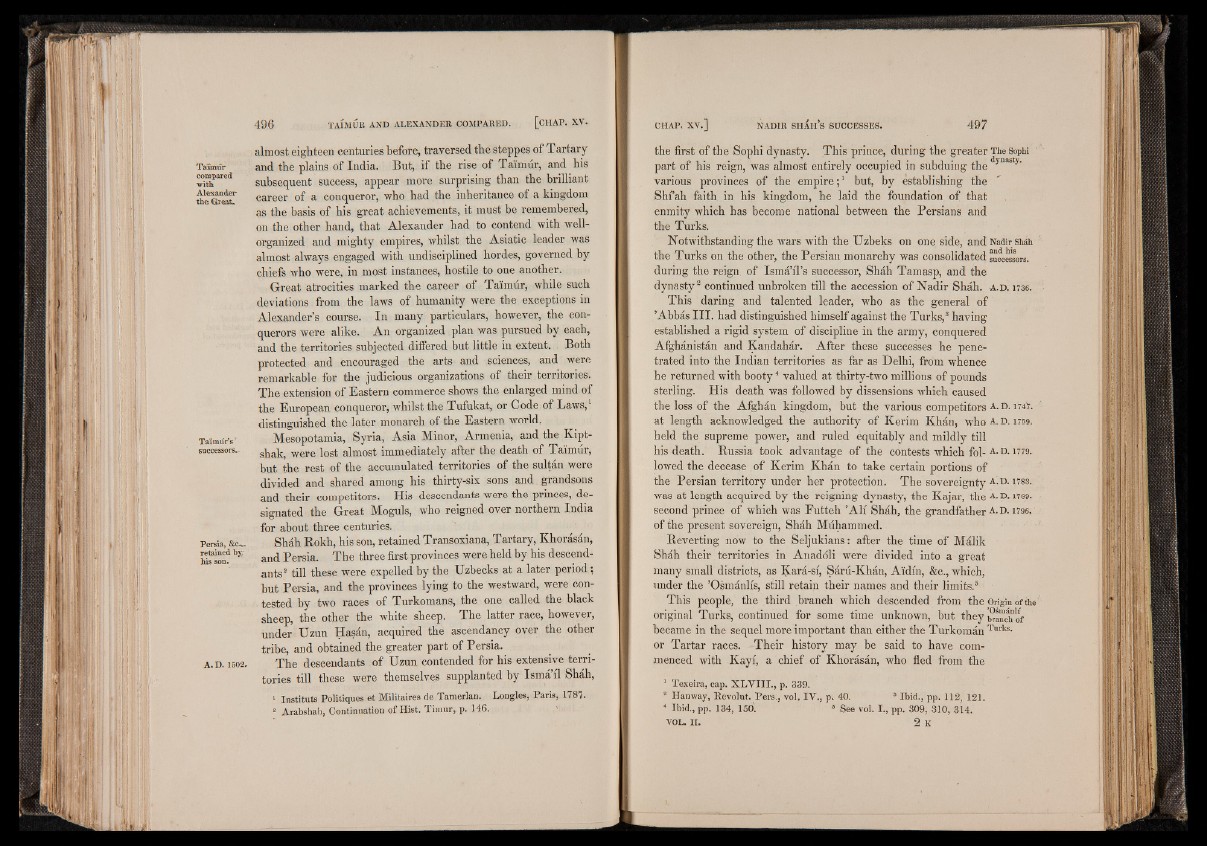
Taïncrar
compared
•witìài
Alexander
th e Great.
Taïmür’s '
successors.-
Persia, &c.„
retained bjy
his son.
A .D . 1502,
almost eighteen centuries before, traversed the steppes of Tartary
and the plains of India. But, if the rise of Taimur, and his
subsequent success, appear more surprising than the brilliant
career of a conqueror, who had the inheritance of a kingdom
as the basis of his great achievements, it must be remembered,
on the other hand, that Alexander had to contend with well-
organized and mighty empires, whilst the Asiatic leader was
almost always engaged with undisciplined hordes, governed by
chiefs who were, in most instances, hostile to one another.
Great atrocities marked the career of Taimur, while such
deviations from the laws of humanity were the exceptions in
Alexander’s course. In many particulars, however, the conquerors
were alike. An organized plan was pursued by each,
and the territories subjected differed but little in extent. Both
protected and encouraged the arts and sciences, and were
remarkable for the judicious organizations of their territories.
The extension of Eastern commerce shows the enlarged mind of
the European conqueror, whilst the Tufukat, or Code of Laws,1
distinguished the later monarch of the Eastern world.
Mesopotamia, Syria, Asia Minor, Armenia, and the Kipt-
shak, were lost almost immediately after the death of Taimur,
but the rest of the accumulated territories of the sultan were
divided and shared among his thirty-six sons and grandsons
and their competitors. His descendants were the princes, designated
the Great Moguls, who reigned over northern India
for about three centuries.
Shah Bokh, his son, retained Transoxiana, Tartary, Khorasan,
and Persia. The three first provinces were held by his descendants2
till these were expelled by the Uzbecks at a later period;
but Persia, and the provinces lying to the westward, were contested
by two races of Turkomans, the one called the black
sheep, the other the white sheep. The latter race, however,
under Uzun Hasan, acquired the ascendancy over the other
tribe, and obtained the greater part of Persia.
The descendants of Uzun contended for his extensive territories
till these were themselves supplanted by Isma il Shah,
1 Institute Politiques et Militaires de Tamerlan. Longles, Paris, 1787.
s Arabshah, Continuation of Hist. Timur, p. 146.
the first of the Sophi dynasty. This prince, during the greater TheSophi
part of his reign, was almost entirely occupied in subduing the dynasty-
various provinces of the empire;1 but, by establishing the
Shfah faith in his kingdom, he laid the foundation of that
enmity which has become national between the Persians and
the Turks.
Notwithstanding the wars with the Uzbeks on one side, and Nadir stah
the Turks on the other, the Persian monarchy was consolidated successors,
during the reign of Isma’il’s successor, Shah Tamasp, and the
dynasty2 continued unbroken till the accession of Nadir Shah. -a . d . 1736.
This daring and talented leader, who as the general of
’Abbas III. had distinguished himself against the Turks,3 having
established a rigid system of discipline in the army, conquered
Afghanistan and Kandahar. After these successes he penetrated
into the Indian territories as far as Delhi, from whence
he returned with booty4 valued at thirty-two millions of pounds
sterling. His death was followed by dissensions which caused
the loss of the Afghan kingdom, but the various competitors A- D-1747.
at length acknowledged the authority of Kerim Khan, who A- d . 1 7 5 9 .
held the supreme power, and ruled equitably and mildly till
his death. Russia took advantage of the contests which fol- A- D. 1 7 7 9 .
lowed the decease of Kerim Khan to take certain portions of
the Persian territory under her protection. The sovereignty AD-1783.
was at length acquired by the reigning dynasty, the Kajar, the A. D. 1789.
second prince of which was Futteh ’Ali Shah, the grandfather A-D- 1796.
of the present sovereign, Shah Muhammed.
Reverting now to the Seljukians: after the time of Malik
Shah their territories in Anadoli were divided into a great
many small districts, as Kara-si, Sâru-Khân, Aïdin, &c., which,
under the ’Osmanlis, still retain their names and their limits.5
This people, the third branch which descended from the Origin of the
original Turks, continued for some time unknown, but they branch of
became in the sequel more important than either the Turkoman Turks-
or Tartar races. Their history may be said to have commenced
with Kayi, a chief of Khorasan, who fled from the
1 Texeira, cap. X L V I I I ., p. 339.
s Hanway, Revolut. Pers., vol. IV ., p. 40. 3 Ibid., pp. 112, 121.
4 Ibid., pp. 134, 150. 5 See vol. I., pp. 309, 310, 314.